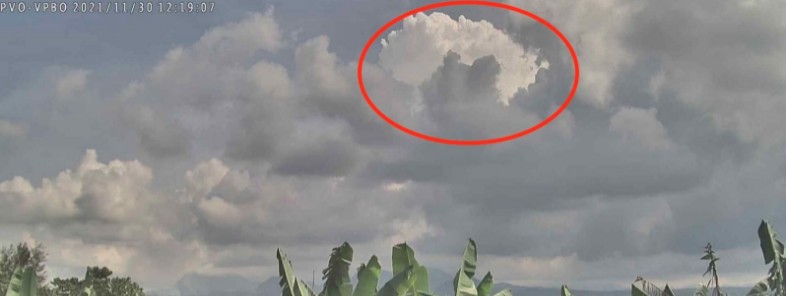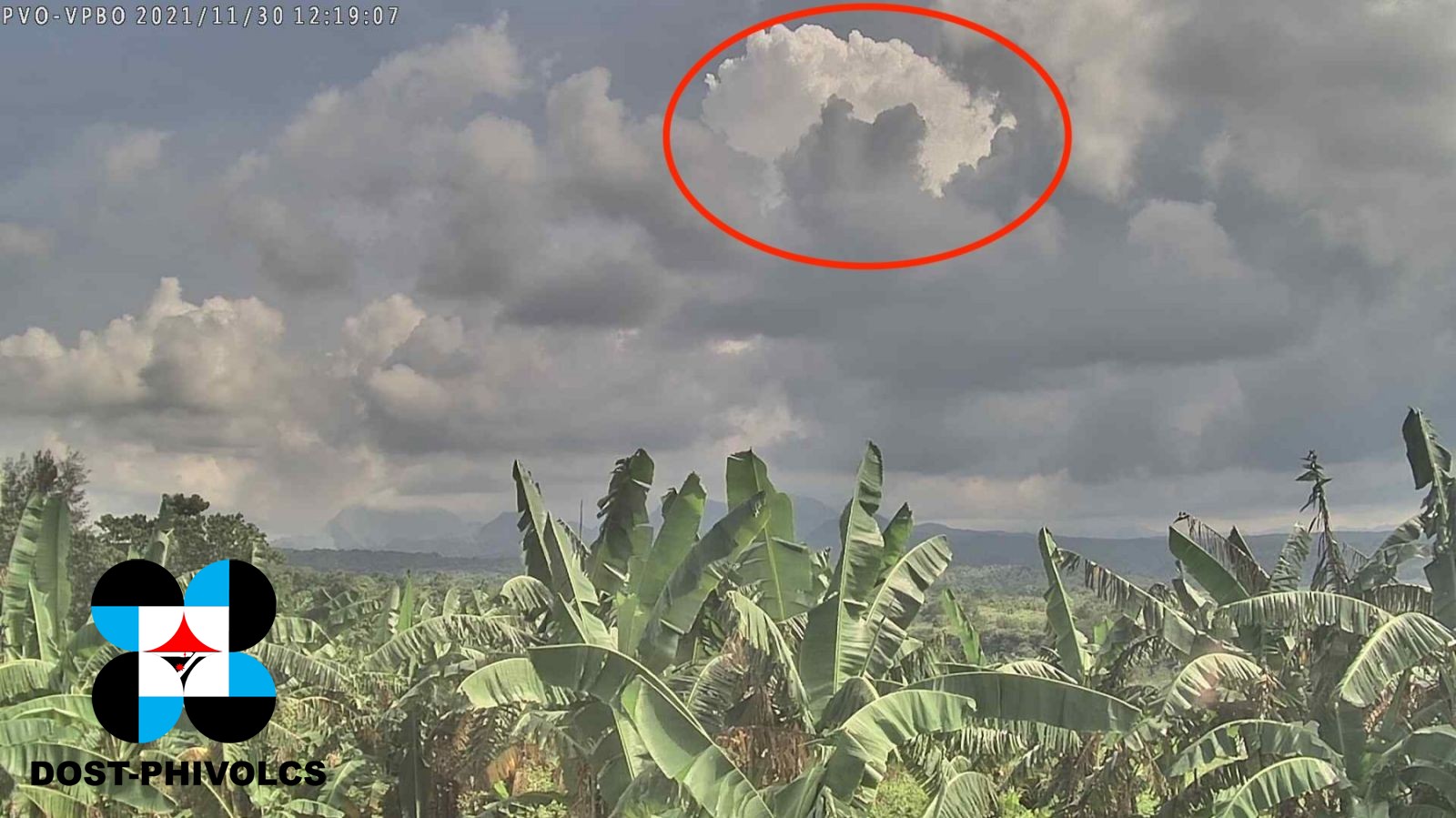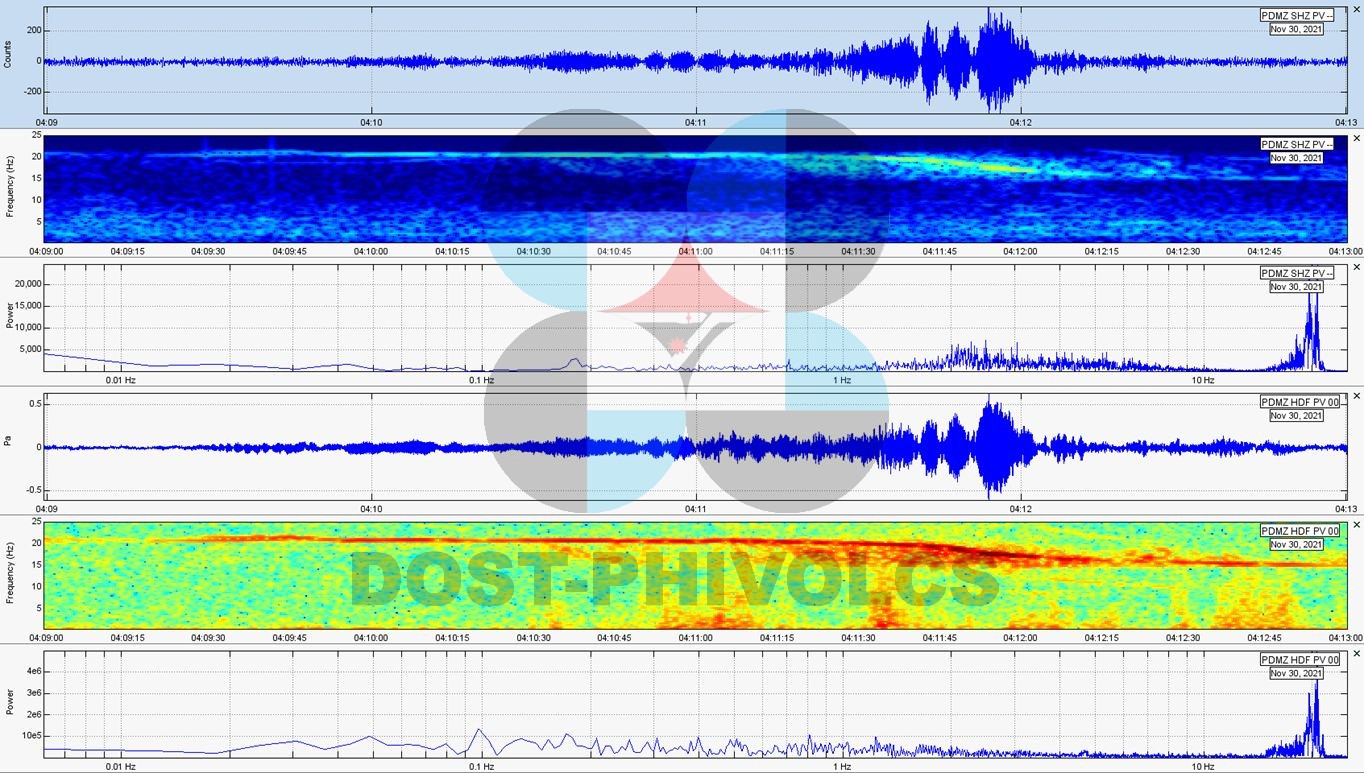Sudden phreatic eruption at Pinatubo volcano, Philippines

A sudden phreatic eruption took place at Pinatubo volcano, Philippines between 04:09 and 04:13 UTC (12:09 – 12:13 PHT) on November 30, 2021. The Tokyo VAAC reported a possible eruption at the volcano with ash observed rising up to 13.4 km (44 000 feet) above sea level at 05:30 UTC.
The event was also confirmed to have occurred after ordnance disposal activities by the AFP, which has no relation to the condition of the volcano, on the northern flanks of Pinatubo conducted prior to noon (LT) today.1
The eruption produced a plume that was detected by the Himawari-8 satellite and reported to DOST-PHIVOLCS by the Tokyo Volcanic Ash Advisory Center (Tokyo VAAC) – with ash observed rising up to 13.4 km (44 000 feet) above sea level at 05:30 UTC.2


So far, there has been no reports of ashfall from communities of Zambales over which the eruption plume dispersed, PHIVOLCS said at 10:00 UTC (18:00 PHT).1
Considering that there has been very low seismic activity in the volcano in the past days and low diffuse volcanic CO2 flux measured at Pinatubo Crater Lake, and high infrasound over seismic energy released by the eruption, the event was likely driven by shallow hydrothermal processes beneath the edifice.
DOST-PHIVOLCS is cautioning the public to refrain from venturing in the vicinities of Pinatubo Volcano at this time.
Local government units are advised to prohibit entry into Pinatubo Crater as shallow phreatic or hydrothermal explosions such as the event of today can occur without warning.
Communities and local government units surrounding Pinatubo are reminded to be always prepared for both earthquake and volcanic hazards and to review, prepare and strengthen their contingency, emergency and other disaster preparedness plans.
DOST-PHIVOLCS continues to strengthen its monitoring of the volcano with ongoing upgrades to the PVN, periodic geochemical surveys of the Pinatubo Crater lake and GPS and satellite analysis of ground deformation.
The prevailing Alert Level 0 status of the volcano is currently under consideration pending the results of ongoing GPS and InSAR data processing.
Pinatubo is the site of the second-largest volcanic eruption of the 20th century. It started on June 15, 1991 (VEI 6) and evolved into by far the largest eruption to affect a densely populated area.
The eruption produced high-speed avalanches of hot ash and gas, giant mudflows, and a cloud of volcanic ash hundreds of miles across. The impacts of the eruption continue to this day, the USGS said.
The following is from USGS Fact Sheet 113-98 — The Cataclysmic 1991 Eruption of Mount Pinatubo, Philippines3
On July 16, 1990, a magnitude 7.8 earthquake — comparable in size to the great 1906 San Francisco earthquake — struck about 100 km (60 miles) northeast of Mount Pinatubo, shaking and squeezing the Earth's crust beneath the volcano.
This earthquake caused a landslide at the volcano, some local earthquakes, and a short-lived increase in steam emissions from a preexisting geothermal area, but otherwise, the volcano seemed to be continuing its 500-year-old slumber undisturbed.
In March and April 1991, however, magma rising toward the surface from more than 32 km (20 miles) beneath Pinatubo triggered small earthquakes and caused powerful steam explosions that blasted three craters on the north flank of the volcano.
Thousands of small earthquakes occurred beneath the volcano through April, May, and early June, and many thousand tons of noxious sulfur dioxide gas were also emitted.
First magma reached the surface from June 7 to 12, 1991.
Because it had lost most of the gas contained in it on the way to the surface, the magma oozed out to form a lava dome but did not cause an explosive eruption.
However, on June 12 — Philippine Independence Day — millions of cubic yards of gas-charged magma reached the surface and exploded in the reawakening volcano's first spectacular eruption.
The volcano exploded in a cataclysmic eruption on June 15, ejecting more than 5 km3 (1 mile3) of material.
The ash cloud from this climactic eruption rose 35 km (22 miles) into the air. At lower altitudes, the ash was blown in all directions by the intense cyclonic winds of a coincidentally occurring typhoon, and winds at higher altitudes blew the ash southwestward.
A blanket of volcanic ash and larger pumice lapilli blanketed the countryside. Fine ash fell as far away as the Indian Ocean, and satellites tracked the ash cloud several times around the globe.
Nearly 20 million tons of sulfur dioxide were injected into the stratosphere, and dispersal of this gas cloud around the world caused global temperatures to drop temporarily (1991 through 1993) by about 0.5 °C (1 °F).
Geological summary
Prior to 1991 Pinatubo volcano was a relatively unknown, heavily forested lava dome complex located 100 km (62 miles) NW of Manila with no records of historical eruptions.
The 1991 eruption, one of the world's largest of the 20th century, ejected massive amounts of tephra and produced voluminous pyroclastic flows, forming a small, 2.5 km (1.5 miles) wide summit caldera whose floor is now covered by a lake.
Caldera formation lowered the height of the summit by more than 300 m (984 feet).
Although the eruption caused hundreds of fatalities and major damage with severe social and economic impact, successful monitoring efforts greatly reduced the number of fatalities.
Widespread lahars that redistributed products of the 1991 eruption have continued to cause severe disruption. Previous major eruptive periods, interrupted by lengthy quiescent periods, have produced pyroclastic flows and lahars that were even more extensive than in 1991.4
References:
1 PINATUBO VOLCANO UPDATE – 30 November 2021 – 6:00 PM – PHIVOLCS
2 TOKYO VAAC – VA Advisory 06:05 UTC, 30/11/21 from RJTD
3 USGS Fact Sheet 113-98 — The Cataclysmic 1991 Eruption of Mount Pinatubo, Philippines – (USGS)
4 Pinatubo – Geological summary – GVP
Featured image credit: PHIVOLCS

Commenting rules and guidelines
We value the thoughts and opinions of our readers and welcome healthy discussions on our website. In order to maintain a respectful and positive community, we ask that all commenters follow these rules:
We reserve the right to remove any comments that violate these rules. By commenting on our website, you agree to abide by these guidelines. Thank you for helping to create a positive and welcoming environment for all.